Book Reviews: Human Factors, Accessibility, & Usability
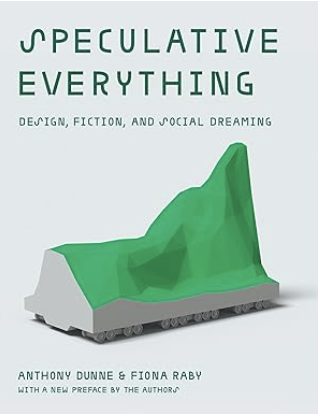
Speculative Everything: Design, Fiction, and Social Dreaming
Anthony Dunne and Fiona Raby. Cambridge, MA: MIT Press. 2024. 240 pages, including index.
Index Terms—alternative realities, biotechnology, design fiction, imaginary scenarios, speculative design
Reviewed by Josh Anderson, Information Architect, Paligo.
Although much has changed technologically since the original 2013 release of Speculative Everything: Design, Fiction, and Social Dreaming, the material holds up well over a decade later in its first paperback edition. The book explores a type of design that concerns itself with representations of alternative realities. It’s less about predicting the future and more about asking “what-if”—for example, how would humans behave differently if we lived 150 years, if we could seed clouds that produce flavored snow, or if we redrew national boundaries around energy sources. The speculative designer draws their audience into these hypothetical scenarios by illustrating glimpses of life in these unreal worlds: an image of an old man atop a toy rocking horse, a drivable ice cream van affixed with (non-working) cloud-seeding canons, or a map of “Eneropa,” a theoretical version of Europe where the continent shares a renewable energy grid. Ultimately, these are designs of ideas; the props or graphics used in their representations are secondary, intended only to be the starting point for the audience’s imagination about what life would be like in a world that produced these artifacts.
Speculative Everything hits its stride in the fourth chapter that focuses on biotechnology. Here, Anthony Dunne and Fiona Raby highlight several speculative design projects that move beyond the entirely theoretical and instead ground themselves in the real-world; my favorite is Common Flowers/Blue Rose, in which the artists reverse-engineered the first commercially available genetically modified flower and disseminated instructions for others to do the same. The point is to unsettle the idea of copyrighting nature. It is at this intersection of art, science, and activism that speculative design is at its most fascinating.
Nearly every page contains a striking photograph, illustration, or model; the result is a book that’s pleasant to flip through. However, it’s when I turned my attention to the text between each image that I realized that most of the speculative design projects are more head-scratching than they are thought-provoking. Many of the images are simply not self-explanatory enough, and even reading what little textual explication the authors might provide, I was often left speculating not about some theoretical alternative existence but about what in the world I was looking at. Without the authors’ long description, there was certainly no way, for example, that I would have guessed a photograph of a person foraging with a comically gargantuan green plastic straw strapped to their back was meant to evoke “overpopulation.”
While Speculative Everything is mostly written for designers and artists, writers will probably resonate with Dunne and Raby’s advice on writing effective fiction: “You can ask an audience to believe the impossible, but not the improbable” (p. 95). The book does a thorough job exploring how and why to create works that transport audiences to another reality, even if some of its examples are more surreal than they are stimulating.
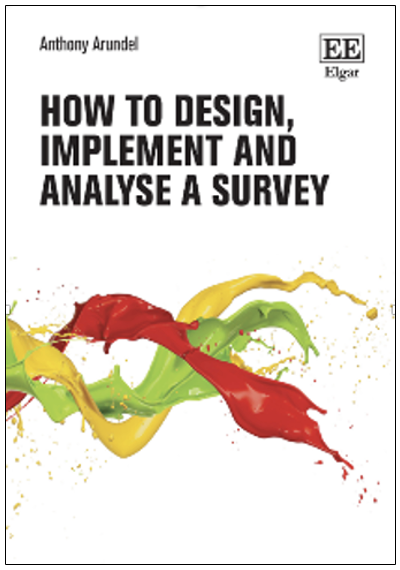
How to Design, Implement, and Analyse a Survey
Anthony Arundel. Northampton, MA: Edward Elgar Publishing Ltd. 2023. 162 pages, including index.
Index Terms—data analysis, questionnaire creation, survey design, survey methods
Reviewed by Charlotte Weddington, Technical Writer, Hunter Douglas.
How to Design, Implement, and Analyse a Survey by Anthony Arundel is a practical guide for those new to survey design, including students, academics, and business managers. The book begins by questioning the necessity of a survey, emphasizing the importance of funding and time constraints. The main advantage of a survey is that it creates new data that is not available from other sources. When creating a new survey, consider asking yourself these two questions: First, do you have sufficient funding? Second, can you work within the time constraints?
Arundel covers survey fundamentals, including types, steps, and budgeting, with a detailed cost example. He then delves into questionnaire design, advising on creating engaging, concise, and jargon-free questions, and compares printed and online questionnaires. Testing questionnaires on colleagues and a sample population is recommended to refine questions and avoid issues.
The book discusses four survey methods: telephone, face-to-face, postal, and online, comparing their tasks and costs. Data processing activities such as collection, coding, entry, and cleaning are explained, including calculating response and non-respondent rates.
For data analysis and reporting, Arundel touches on sample weighting, common method bias, and non-random samples, referring readers to econometric textbooks for statistical methods. He concludes with advice on adopting new survey methods cautiously, ensuring they are backed by sufficient research. Arundel includes a table on page 80 that compares the tasks and costs between the four methods.
In the final chapter, the author summarizes the book by topic and concludes by offering advice on adopting new survey methods carefully. Arundel says, “Make sure that there is sufficient research to establish that the method is effective for the types of individuals that you want to survey” (p. 133).
Overall, How to Design, Implement, and Analyse a Survey is a thorough and practical resource, offering valuable tips and best practices for conducting surveys, making it highly recommended for those interested in survey methodology.
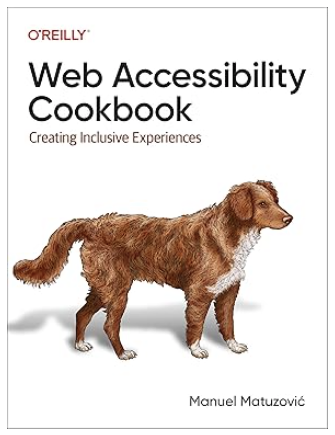
Web Accessibility Cookbook: Creating Inclusive Experiences
Manuel Matuzović. Sebastopol, CA: O’Reilly Media. 2024. 382 pages, including index.
Index Terms—accessibility tools, questionnaire creation, survey design, Web accessibility
Reviewed by Danang Handoko Belut Saputro, Student, Universitas Gadjah Mada, supported by Lembaga Pengelola Dana Pendidikan (LPDP), Indonesia.
Web Accessibility Cookbook: Creating Inclusive Experiences provides developers with practical “recipes” for creating accessible web components such as navigation, tables, and dialogs while explaining the rationale behind these methods. By emphasizing a clear, logical document structure and the use of hidden headings to enhance screen reader navigation, the guide ensures that both visual and assistive technology users can effectively interact with digital content. The book underscores the critical importance of accessibility in web development, offering solutions that address diverse user needs and preferences to facilitate seamless interaction with websites, including accessing information, registering for services, and making purchases.
Manuel Matuzović outlines methods for improving web accessibility, though specific details are not fully provided. He highlights accessibility as a fundamental aspect of web development, suggesting its integration throughout all stages, from design to implementation. One approach is to use ARIA (Accessible Rich Internet Applications) attributes and semantic HTML to improve accessibility while cautioning against misuse, which can have a negative impact on screen readers. Matuzović also offers practical “recipes” for developers, likely as step-by-step guides or best practices for creating accessible components like navigation, tables, and dialogs. Testing and validation, through automated or manual methods, are essential to ensure compliance with accessibility standards. These methods represent a comprehensive approach, focusing on the technical and practical application of accessibility principles to create inclusive web experiences.
Best practices include using ARIA attributes and semantic HTML, like ARIA roles and labels, to improve screen reader comprehension and enhance accessibility for users with disabilities. Tools like Axe DevTools, Google Lighthouse, WAVE, ARC Toolkit, and IBM Equal Access Accessibility Checker help developers identify and fix accessibility issues, ensuring compliance with standards. Avoiding empty elements is key, as they can confuse screen readers and disrupt navigation. Providing descriptive rather than generic link text helps users understand the purpose of links. Lastly, maintaining accessibility in customizable components and educating developers on these practices are essential.
This book’s strength lies in its comprehensive coverage of web accessibility, which includes strategies such as document structuring, HTML, and JavaScript implementation for essential components like toggles and modals. Its practical guidance explains not only how to implement accessibility features, but also the reasons behind them, with a focus on HTML and JavaScript. The book also highlights voice accessibility for users relying on voice commands. However, its weaknesses include redundant links that may confuse screen readers and an excessive focus on HTML, which may be insufficient for developers seeking modern technologies.
Web Accessibility Cookbook highlights the crucial role of accessibility in web development, offering practical guidance and strategies for creating inclusive web components that ensure usability for everyone. Aimed primarily at front-end developers, it also serves web designers and accessibility advocates by providing best practices for building accessible digital experiences. Both beginners and seasoned professionals can easily navigate its recipe-based format, which provides them with the necessary knowledge to improve accessibility in their projects.
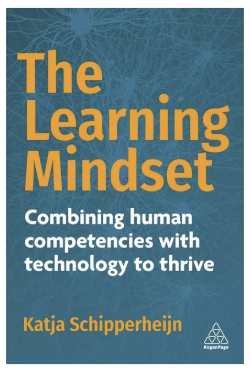
The Learning Mindset: Combining human competencies with technology to thrive
Katja Schipperheijn. New York, NY: Kogan Page. 2024. 248 pages, including index.
Index Terms—AI integration, human competencies, learning mindset, professional development, technological innovations
Reviewed by Valentina DiPeri
For professionals filled with anxiety about the advent of AI, Katja Schipperheijn’s The Learning Mindset: Combining human competencies with technology to thrive is a must-read book. She teaches readers how to be excited about the possibilities technological innovations bring.
Schipperheijn devotes this book to helping readers understand the learning mindset, its importance, and how individuals and professional communities can adopt it. “Certain skills may no longer be relevant because AI has become more powerful or because skills and knowledge are increasingly learnt on the spur of the moment,” she writes (p. 99).
In Chapter 1, Schipperheijn explains that the learning mindset builds on the growth mindset, the belief that individuals can improve their intelligence if they “embrace challenges, overcome obstacles and see failures as opportunities for personal development” (p. 7). A learning mindset turns that belief into action by requiring an “openness to new experiences, curiosity and a constant drive to increase understanding in different areas” (p. 7).
Schipperheijn offers a dose of realism to anyone in denial about the changes AI will precipitate. Chapter 2 addresses aspects of AI that instill fear in people, making them worry AI will replace them. She describes the similarities between how humans and AI learn, using feedback mechanisms and reinforcement learning. She also highlights innovations such as brain-computer interfaces that will increasingly intertwine AI and the human brain.
Chapter 4 describes what humans can bring to the human-machine partnership. Schipperheijn reassures us that being open to the possibilities of AI will not make us irrelevant because some competencies, like curiosity, imagination, resilience, optimism, and empathy, are intrinsically human.
The Learning Mindset progressively builds excitement around learning by describing how learning influencers can inspire others, how to become a learning leader, and how to create an entire learning ecosystem. The book brims with optimism and is an essential read in this time of rapid change. Schipperheijn aims to make readers excited about adopting a learning mindset so they can thrive in a world with AI. “Hoping it all won’t take off is a utopia…The only question you can ask yourself is how can I still be human in a world that is increasingly artificial and virtual” (p.37). Her answer is that we can thrive in this new world by adopting a “learning mindset.”
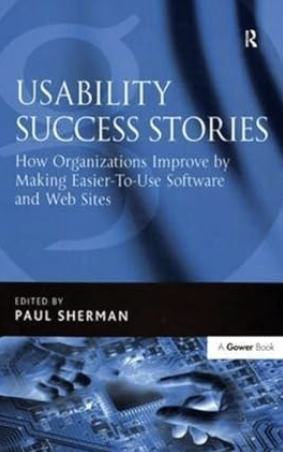
Usability Success Stories: How Organizations Improve by Making Easier-To-Use Software and Web Sites
Paul Sherman, ed. New York, NY: Routledge. 2024. 204 pages, including index.
Index Terms—case studies, professional development, technological innovations, usability engineering, user-centered design
Reviewed by Dylan Fisher
Usability Success Stories: How Organizations Improve by Making Easier-To-Use Software and Web Sites is filled with the expertise of Paul Sherman and researched case studies that demonstrate successful businesses that focus on the user. Dubbed usability engineering, this field focuses on user-centered design (UCD) and aims to create a product that can achieve technical goals while still maintaining simplicity and ease of use. Sherman notes that while usability practices have existed for some time, many companies are still working to fully integrate them into their workflows. The storytelling approach Sherman uses with the case studies, or “success stories,” is a usability approach for his readers. He presents the information in an engaging, compelling way intended to support the reader on the path to their own success. By including real-world examples and meshing them with storytelling narratives, Sherman not only informs but captivates his readers.
In Chapter 3, Francis Henry shares a narrative, “Tales from the Trenches: Getting Usability Through Corporate.” Through his own experiences, Henry recounts the trials and challenges of advocating for usability within large organizations. He brings us along on his journey of trying to convince businesses of the value of solid usability practices, offering a real look at the frustrations and setbacks he faced. As we follow Henry through these struggles, we also gain valuable insights and advice on how to overcome them. From securing small wins that gradually improve usability to making the case for the business advantages of UCD, Henry’s stories offer hard-earned lessons on navigating the corporate landscape.
Sherman advises that readers learn from these success stories to implement UCD into their professions and become a user advocate. The change must happen from within the “organisations in those fuzzy areas between disciplines” (p. 191). Sherman’s excitement for user-centered design and the motivation he aims to give his readers creates a hopeful outlook for the future of usability. The change in organizations might be slow, but reachable. Business models are shifting and becoming advocates for the users. Improvements like this will increase profits from rising user satisfaction as have the companies that Sherman case studies explored have done.
Usability Success Stories offers valuable insights into the field of usability engineering. Sherman’s storytelling approach makes complex concepts accessible, while also engaging readers with the challenges and triumphs of those advocating for usability within large organizations. I personally found the book motivating, easy to read with a clear message, and it will serve as a very useful guide for anyone who reads it.
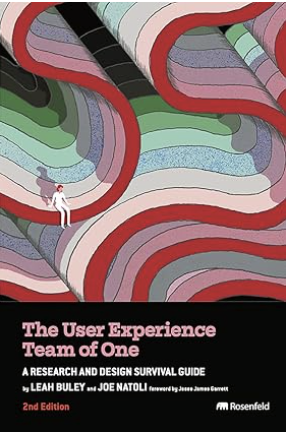
The User Experience Team of One: A Research and Design Survival Guide, 2nd ed.
Leah Buley and Joe Natoli. Brooklyn, NY: Rosenfeld Media. 2024. 320 pages.
Index Terms—case studies, interdisciplinary approach, usability engineering, user-centered design, UX practices
Reviewed by Lynne Cooke, Clinical Assistant Professor, Arizona State University
I was excited to see the second edition of The User Experience Team of One: A Research and Design Survival Guide by Leah Buley and Joe Natoli since I have been using the first edition in my undergraduate and graduate classes for years. Students appreciate Buley’s detailed discussion of the different usability test and evaluation methods with Chapter 1, “UX 101,” setting the stage for the interdisciplinary approach the authors employ.
Buley and Natoli explore the business side of user experience (UX) in this latest edition in chapters discussing scrum, lean and agile methods; competitor analysis: and strengths, weaknesses, opportunities, and threats (SWOT). They also draw on fields such as user research, user-centered design, information architecture, and interaction design, as well as including an easy-to-follow methodology for implementing these interdisciplinary approaches to UX.
The sections on using Method Cards and Tips for Bypassing Objections offer information on how to bridge the gap between the stakeholders and the users. Particularly useful are the responses to often raised objections to UX. Buley and Natoli explore these issues in chapters such as “Just Make the UI Look Better,” “But We Already Do Market Research,” “User Experience is Too Expensive,” and “It Takes Too Much Time.” There are additional objections to incorporating UX into the project lifecycle which they also address with compelling arguments.
One of my favorite new chapters, “Growing Yourself and Your Career,” includes excellent discussions of the different UX focused organizations including The Interaction Design Association (IxDA), Agile UX, and User Experience Professional (UXPA) International. They also mention UX meetups and include several online resources to help both novice and experts alike.
The User Experience Team of One is full of practical advice with detailed information about how to implement different usability test and evaluation practices. There are numerous tips, notes, and hints that reflect the authors’ depth of experience. The “If You Only Do One Thing” feature provides readers with a concrete starting point for applying the content in each chapter.
The updated version of The User Experience Team of One is a comprehensive guide to the UX experience. You do not have to be a team of one to benefit from the methodological approach that Buley and Natoli use to guide the reader through each step of the process. This is an insightful book which provides great advice for neophyte and experienced UX practitioners, one which I highly recommend.

